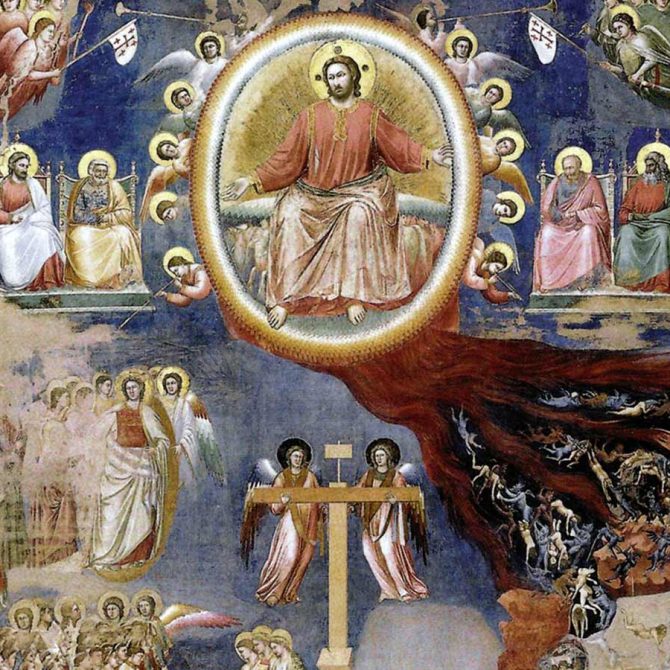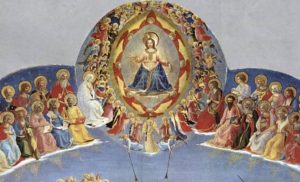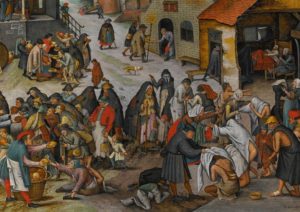This is the eleventh in a series of articles on the Four Last Things: death, judgment, Heaven, and Hell.
 Today we come to the final of the Four Last Things: Hell. I have written extensively on this topic over the years, largely in response to the widespread dismissal of the revealed doctrine of Hell. In contradiction to Scripture, many presume that Hell is an unlikely destination for most. Never mind that Jesus taught just the opposite (e.g., Matt 7:13-14). In my own small way, I have tried to keep people more rooted in the sobriety of the Gospel than in the wishful thinking of the modern age. No one warned of Hell more than did Jesus. Arguably, 21 of the 38 parables amount to warnings about Hell and the need to be ready for judgment day. (I have written more on that here: Jesus Who Loves You Warned Frequently of Hell.)
Today we come to the final of the Four Last Things: Hell. I have written extensively on this topic over the years, largely in response to the widespread dismissal of the revealed doctrine of Hell. In contradiction to Scripture, many presume that Hell is an unlikely destination for most. Never mind that Jesus taught just the opposite (e.g., Matt 7:13-14). In my own small way, I have tried to keep people more rooted in the sobriety of the Gospel than in the wishful thinking of the modern age. No one warned of Hell more than did Jesus. Arguably, 21 of the 38 parables amount to warnings about Hell and the need to be ready for judgment day. (I have written more on that here: Jesus Who Loves You Warned Frequently of Hell.)
In this post, however, I would like to consider why Hell has to be. Frequently, those who doubt Jesus’ biblical teaching ask this: If God is love, then why is there Hell and why is it eternal?
In short, there is Hell because of God’s respect for our freedom. God has made us free and our freedom is absolutely necessary if we are to love. Suppose that a young man wanted a young lady to love him. Suppose again that he found a magic potion with which to lace her drink. After drinking it, Presto, she “loves” him! Is it real love? No it’s the effect of chemicals. Love must be freely given. The yes of love is only meaningful if we are free to say no. God invites us to love him. There must be a Hell because there has to be a real alternative to Heaven. God will not force us to love Him or to come to Heaven with Him.
But wait a minute; doesn’t everyone want to go to Heaven? Yes, but it is often a “heaven” as they define it, not the real Heaven. Many people understand Heaven egocentrically: It’s a place where they will be happy on their own terms, where what pleases them will be available in abundance. The real Heaven is the Kingdom of God in all its fullness. So while everyone wants to go to a “heaven” as they define it, not everyone wants to live in the Kingdom of God in all its fullness. Consider the following examples:
- The Kingdom of God is about mercy and forgiveness. Not everyone wants to show mercy or forgive. Some prefer revenge. Others favor severe justice. Some prefer to cling to their anger and nurse resentments or bigotry. Further, not everyone wants to receive mercy and forgiveness. Some cannot possibly fathom why anyone would need to forgive them since they are right! Recall the second son in the Parable of the Prodigal Son. Instead of entering the feast at the pleading of his father, he refuses to enter because that wretched brother of his is in there. He will not forgive or love his brother as the father does. In so doing, he excludes himself from the feast. Despite his father’s pleading, he will not enter through forgiveness and mercy. The feast is not a feast at all for him. Similarly, Heaven will not be “heaven” for those who refuse the grace to forgive and love their enemies and those who have harmed them.
- The Kingdom of God is about chastity. God is very clear with us that His Kingdom values chastity. For the unmarried, this means no genital sexual contact. For the married, this means complete fidelity to each other. Further, things such as pornography, lewd conduct, and immodesty are excluded from the Kingdom. Many people today do not prefer chastity. They would rather be unchaste and immodest. Many celebrate fornication and homosexual acts as a kind of liberation from “repressive” norms. Many people like to consume pornography and do not want to limit their sexual conduct. It is one thing to fail in some of these matters through weakness, but it is quite another to insist that there is nothing wrong with such behavior.
- The Kingdom of God is about Liturgy. All of the descriptions of Heaven emphasize liturgy. There are hymns being sung. There is the praise of God. There is standing, sitting, and prostrating at certain times. There are candles, incense, and long robes. There is a scroll or book that is opened, read, and appreciated. There is the Lamb on a throne-like altar. It’s all very much like the Mass—but many are not interested in things like the They stay away because the say it’s “boring.” Perhaps they don’t like the hymns and all the praise. Perhaps the scroll (the Lectionary) and its contents do not interest them or agree with their moral preferences. Having God at the center rather than themselves is unappealing.
The point is this: If Heaven isn’t just of our own design; if Heaven—the real Kingdom of God—is about these things, then doesn’t it seem clear that there actually are many who don’t want to go to Heaven? You see, everyone wants to go to a “heaven” of their own design, but not everyone wants to live in the real Kingdom of Heaven. God will not force any one to live in Heaven if he doesn’t want to live there. He will not force anyone to love Him or what He loves or whom He loves. We are free to choose His Kingdom or not.
Perhaps a brief story will illustrate my point:
I once knew a woman in one of my parishes who in many ways was very devout. She went to daily Mass and prayed the rosary on most days. There was one thing about her, however, that was very troubling: she couldn’t stand African-Americans.
She would often comment to me, “I can’t stand Black people! They’re moving into this neighborhood and ruining everything! I wish they’d go away.” I remember scolding her a number of times for this sort of talk, but it seemed to have seeming effect.
One day I decided to try to make it more clear: “You know you don’t really want to go to Heaven,” I challenged.
“Of course I do, Father,” she replied. “God and the Blessed Mother are there; I want to go.”
“No, you won’t be happy there,” I responded.
“Why?” she asked, “What are you talking about, Father?”
“Well you see there are Black people in Heaven and you’ve said that you can’t stand to be around them, so I’m afraid you wouldn’t be happy there. God won’t force you to live in Heaven if you won’t be happy there. That’s why I think that you don’t really want to go to Heaven.”
I think she got the message because I noticed that her attitude started to improve.
That’s just it, isn’t it? God will not force us to live in the Kingdom if we really don’t want it or like what that Kingdom is. We can’t just invent our own “heaven.” Heaven is a real place. It has contours and realities of its own that we can’t just brush aside. Either we accept Heaven as it is or we ipso facto choose to live apart from it and God. So, Hell has to be. It is not a pleasant place, but I suppose the saddest thing about the souls in Hell is that they wouldn’t be happy in Heaven anyway. It’s a tragic plight, not to be happy anywhere.
Understand this, too: God has not utterly rejected even the souls in Hell. Somehow, He still provides for their basic needs. They continue to exist and thus God continues to sustain them with whatever is required for that existence. He does not annihilate them or snuff them out.
God respects their wish to live apart from the Kingdom and its values. He loves them but respects their choice.
Why is Hell eternal? Here I think we encounter a mystery about ourselves. God seems to be teaching us that there comes a day when our decisions are fixed forever. In this world we always have the possibility of changing our mind so the idea of a permanent decision seems strange to us. Those of us who are older can testify that as we age we get more and more set in our ways; it’s harder and harder to change. Perhaps this is a little foretaste of a time when our decisions will be forever fixed and we will never change. The Fathers of the Church used an image of pottery to teach on this. Think of wet clay on a potter’s wheel. As long as the clay is moist and still on the wheel it can be shaped and reshaped, but once it is put in the kiln, in the fire, its shape is fixed forever. So it is with us that when we appear before God, who is a Holy Fire, our fundamental shape will be forever fixed, our decisions will be final. This is mysterious to us and we only sense it vaguely, but because Heaven and Hell are eternal, it seems that this forever-fixed state is in our future.
This is the best I can do on a difficult topic: Hell has to be. It’s about God’s respect for us. It’s about our freedom and summons to love. It’s about the real Heaven. It’s about what we really want in the end. We know what God wants: to save us. The real judgment in question is what we want.









